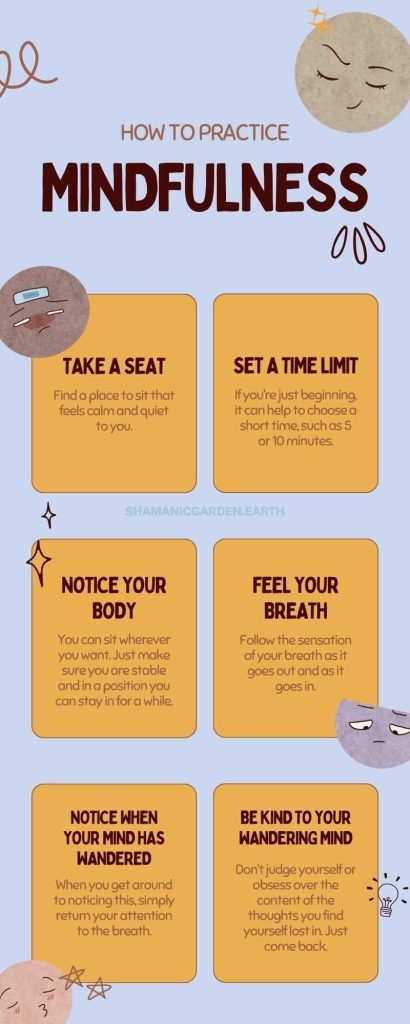The practice of mindfulness can help reduce stress, enhance emotional balance, increase self-awareness, and promote a general sense of well-being. It involves bringing your complete attention to the present moment without judgment or distraction. To understand the concept better, let’s look at how to practice mindfulness using simple steps.
Take a Seat

The first step in practicing mindfulness is to find a comfortable place where you can sit undisturbed. This can be on a chair, a cushion, or even on the floor, depending upon your comfort level. Choose a quiet spot free from potential distractions so that you can fully concentrate on the practice.
Your posture also plays a critical role. Keep your back straight but relaxed, not too tense or too slack. Rest your hands in your lap or on your knees. Allow your eyes to gently close, or if you prefer, keep them half-open and gaze softly at the floor in front of you. This position allows for a balance of relaxation and alertness – a key aspect of mindfulness practice.
Set a Time Limit
When beginning mindfulness practice, it can be helpful to set a specific time limit. It could be as little as 5 minutes or as much as 20, but setting a limit can provide a sense of structure and manageability, especially for beginners.
Over time, as your comfort and skill with mindfulness increase, you can extend this time according to your preference. Use a gentle-sounding timer, so you’re not startled when your practice time is up.
Notice Your Body
In our day-to-day lives, we often lose touch with our bodies. One of the initial steps of mindfulness practice involves reconnecting with our physical selves. After you’ve settled into your position, start by noticing the weight of your body pressing down onto the chair or floor. Feel the texture of your clothes against your skin, the temperature of the air around you.
Scan your body from top to bottom, noting any areas of tension or discomfort, but without trying to change anything. The goal isn’t to alter or fix, but simply to notice. This body scan helps ground you in the physical reality of the present moment.
Feel Your Breath
Next, shift your attention to your breath. Don’t try to control or manipulate it in any way; instead, just observe it as it is. Feel the sensation of the breath as it enters your nostrils, fills your lungs, and then leaves your body. Pay attention to the rise and fall of your chest or abdomen with each breath.
Focusing on your breath anchors your mind, offering a point of concentration. It’s normal for your mind to wander; whenever it does, gently return your attention to the sensation of the breath.
Notice When Your Mind Has Wandered
It’s a common misconception that the goal of mindfulness is to empty the mind completely. But in fact, a crucial part of the practice is the recognition of when your mind has wandered off. The moment you realize you’ve been lost in thought is a moment of mindfulness.
When you notice your mind has strayed from the breath, don’t criticize or judge yourself. Instead, acknowledge where it went, then gently steer it back to the breath. It’s this repeated process of wandering and return that strengthens your mindfulness “muscle.”
Be Kind to Your Wandering Mind
Lastly, it’s essential to maintain an attitude of kindness and patience towards your wandering mind. Don’t get frustrated if your thoughts keep drifting away. This is what minds do; it’s their nature to think, to wander.
Whenever you notice your mind wandering, treat it as a friend who has lost their way. Gently guide it back to the breath, again and again. This compassionate approach towards your own mind cultivates a
sense of self-compassion, understanding, and patience. It also helps you to navigate life’s ups and downs with more grace and resilience.
Mindfulness is not about achieving a specific goal or state of mind but is a practice of continually returning to the present moment. It involves noticing and accepting things as they are, moment by moment, without judgment or reaction. Over time, mindfulness can cultivate a deeper sense of peace, balance, and well-being in your daily life.
In Conclusion
Mindfulness is a practice that can be cultivated by anyone. It doesn’t require special tools or environments, only your presence and commitment. Start with taking a seat, setting a time limit, noticing your body, feeling your breath, recognizing when your mind has wandered, and finally, being kind to your wandering mind.
Remember that patience is key: mindfulness isn’t about perfection, but about continually coming back to the present moment. Over time, with consistent practice, you’ll begin to notice a greater sense of calm and clarity permeating your life.
Regardless of how busy or stressful your life might be, taking time each day to engage in mindfulness can have significant benefits. Not only can it reduce stress and enhance well-being, but it can also help you become more attuned to your experiences, fostering a deeper connection with yourself and the world around you. So, take a seat and take a moment – your mindfulness journey begins now.
Ten Positive Affirmations to Help Develop a Daily Mindfulness Practice
- I am committed to practicing mindfulness daily, allowing myself to fully engage with the present moment.
- Each day, I am becoming more aware of my thoughts, emotions, and sensations, and I embrace them with compassion and non-judgment.
- My mindfulness practice empowers me to let go of worries about the past and anxieties about the future, bringing me peace and serenity in the present.
- I am grateful for the simple joys and beauty that surround me each day, and I take moments to appreciate them fully.
- With each breath, I deepen my connection to the present moment, grounding myself in the here and now.
- I approach challenges and difficulties with mindfulness, observing them with curiosity and openness, knowing that I have the inner resources to navigate them.
- My daily mindfulness practice strengthens my mind, body, and spirit, promoting overall well-being and resilience.
- I give myself permission to take regular breaks throughout the day, allowing myself to pause, breathe, and reconnect with the present moment.
- I cultivate self-compassion and treat myself with kindness and understanding as I navigate the ups and downs of life.
- Each day, I become more attuned to the needs of my body, mind, and soul, and I make choices that support my overall health and happiness.



